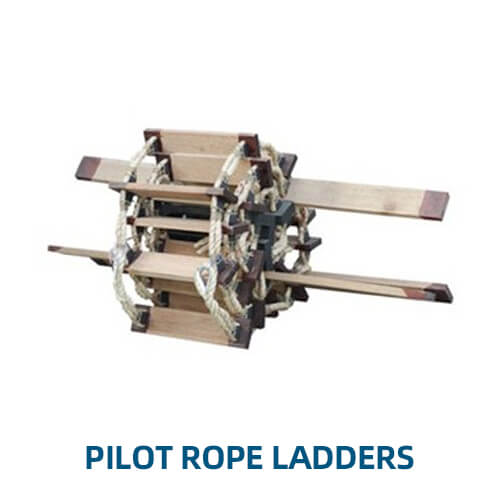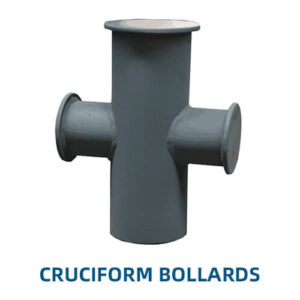Key Features of a Pilot Rope Ladder:
- Construction and Materials:
- Rope Sides: The ladder features strong, durable ropes on either side, typically made from high-tensile manila or synthetic fibers like polyester. These ropes are resistant to wear, saltwater, and UV exposure, ensuring long-term durability.
- Rigid Rungs: The rungs are usually made from hardwood, aluminum, or synthetic materials, spaced evenly along the ropes. They are sturdy enough to support the weight of individuals climbing up or down, and are designed to prevent slipping.
- Reinforced Steps: Some rungs may be reinforced with rubber or grooves to enhance grip, ensuring safety in wet or challenging conditions.
- Design and Functionality:
- Length and Flexibility: The length of pilot ladders varies depending on the height of the ship’s freeboard (the distance from the deck to the waterline). The ladder is flexible, allowing it to contour to the shape of the ship’s hull when deployed.
- Spreader Steps: To prevent the ladder from twisting or getting tangled, spreader steps (longer steps) are placed at regular intervals. These steps ensure that the ladder remains straight and stable against the ship’s side.
- Portability: Pilot rope ladders are lightweight and can be easily rolled up and stored when not in use. They can be quickly deployed when a pilot boat approaches.
- Safety Features:
- Anti-Twist Design: The inclusion of spreader steps prevents the ladder from twisting, which is a critical safety feature during the transfer process.
- Secure Attachment Points: The top of the ladder is securely attached to strong points on the ship, ensuring it remains firmly in place during use. This prevents slippage or sudden movements that could endanger the pilot.
- Compliance with Regulations: Pilot ladders are designed to meet international safety standards, including those set by the International Maritime Organization (IMO) and SOLAS. These standards govern the construction, materials, and deployment of pilot ladders to ensure maximum safety.
- Applications:
- Pilot Boarding and Disembarking: The primary use of pilot rope ladders is for the safe boarding and disembarking of maritime pilots from pilot boats to the ship and vice versa. This process is critical during the navigation of vessels through ports, harbors, and other restricted waters.
- Emergency Use: In some cases, pilot ladders may also serve as emergency escape routes if other means of disembarkation are unavailable.
- Deployment and Use:
- Quick Deployment: The ladder can be quickly deployed over the side of the ship when the pilot boat approaches. The top of the ladder is securely fastened to designated points on the deck, often with additional safety lines or chains for extra security.
- Height Adjustability: The length of the ladder is adjusted to ensure it reaches the deck of the pilot boat while being long enough to accommodate any height differences due to the ship’s freeboard or sea conditions.
- Maintenance and Inspection:
- Regular Inspections: To ensure safety, pilot ladders must be regularly inspected for signs of wear, such as frayed ropes, cracked rungs, or corrosion on metal fittings. Any damaged parts should be repaired or replaced immediately.
- Proper Storage: When not in use, the ladder should be stored in a dry, protected area to prevent damage from the elements and to ensure it is in good condition when needed.
Advantages of a Pilot Rope Ladder:
- Critical Safety Role: Provides a safe means of transferring pilots, which is essential for the safe navigation of vessels in challenging waters.
- Durability: Constructed to withstand harsh marine conditions, ensuring reliability over time.
- Compliance with Standards: Designed to meet rigorous international safety standards, ensuring that they are safe and reliable for use in all required situations.
Considerations When Using a Pilot Rope Ladder:
- Training and Familiarization: Crew members should be properly trained in the deployment and use of pilot ladders to ensure the safety of the pilots and the efficiency of the transfer process.
- Environmental Conditions: The use of the ladder may be influenced by environmental factors such as rough seas, strong winds, or poor visibility. Extra precautions may be necessary in such conditions.
- Regular Maintenance: Consistent maintenance and inspections are critical to ensure that the ladder remains in safe working condition, especially since it plays a vital role in the safe transfer of pilots.
A Pilot Rope Ladder is an indispensable tool in maritime operations, specifically designed to facilitate the safe transfer of maritime pilots between vessels and pilot boats. With its robust construction, safety features, and compliance with international standards, the pilot rope ladder ensures that pilots can perform their crucial navigational duties without compromising their safety. Proper training, regular maintenance, and adherence to safety protocols are essential to maximizing the effectiveness and safety of this critical piece of maritime equipment.






